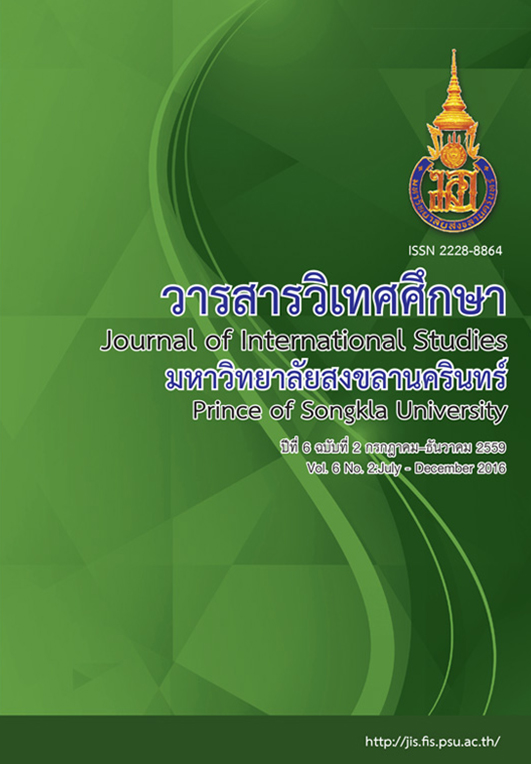Designing The Street Market Model of Rawai District, Phuket
Main Article Content
Abstract
This research aimed to 1) survey the Rawai community in Phuket and explore needs of the locals, business owners, and tourists, 2) examine problems found from and suggestions for the street market organization, and 3) design the street market model of Rawai District, Phuket.
Research participants consisted of 25 tourism and cultural operators, local community leaders, and Thai wisdom scholars; 205 local residents of Rawai District, business owners, local administrations, and 70 tourists in Rawai.
Research findings revealed that all groups of the participants were in agreement that it is necessary to held a street market in Rawai District to provide visitors with an alternative tourist place and to attract more visitors to Rawai District. By so doing, it will increase both job opportunities and the locals’ income which will help strengthen the Rawai Community. In addition, community enterprises and tourism will be promoted. A street market is a new type of tourist attractions where local ways of life and culture are demonstrated through a variety of events and activities such as local product stalls, food and dessert stalls, performances of local art and culture, and demonstrations of community enterprises’ products.
However, several organizational problems including setting, management, traffic, parking spaces, security, advertisement, and sanitation arose. Therefore, there was public hearing to find solutions to such problems, and it was suggested that Rawai District include a street market project in life quality and tourism development plan of the next fiscal year so that its development can be run in parallel with the policy of Rawai District Furthermore, cooperation from both local residents and government sectors as well as private sectors are also keys to the success of the street market organization.
Three ethnic groups which are the Buddhist, the Muslim and the Sea-Gypsy residing in Rawai District were taken into consideration when designing the model of Rawai street market. This model divides the market into different zones; Zone A sells general products, Zone B is for local souvenirs, OTOP products, and local community enterprises’ products, Zone C is for local Thai, Muslim, and Sea-Gypsy’s cuisines as well as international food, and Zone D is reserved for cultural events and dining tables. Also, the Buddhist, the Muslim, the Sea-Gypsy, and other foreign settlers who live in Rawai District will be encouraged to participate in events and activities there, so the place can develop its own character and uniqueness.
Article Details
Statements and opinions expressed in articles herein are those of the authors and do not necessarily reflect the position of the editors or publisher.
Article, information, text, image, etc. which are published in Journal of International Studies, belong to Journal of International Studies. If anybody or any organization would like to use part or whole of them, they must receive written permission from Journal of International Studies before usage.
References
กาญจนา พันธ์นุช. (2558).ช้าง...ป่า...กับการอนุรักษ์.ม.ป.ป. ค้นเมื่อ 9 สิงหาคม 2558 จาก <http://www.chaipat.or.th>
จารุดา อูปเสาร์. (2555). การศึกษาเปรียบเทียบการบริหารจัดการถนนคนเดินท่าแพ วัวลาย และสันกำแพง จังหวัดเชียงใหม่. วิทยานิพนธ์ รป.ม., มหาวิทยาลัยเชียงใหม่.
จำรัสนองมาก.(2541).“การบริหารงานธุรการ,” ใน เอกสารการสอนชุดวิชาการจัดการโรงเรียนประถมศึกษา. นนทบุรี: มหาวิทยาลัยสุโขทัยธรรมาธิราช.
ชิดจันทร์ หังสสูต. (2532). หลักและการจัดการอุตสาหกรรมการท่องเที่ยว. กรุงเทพฯ: คณะบริหารธุรกิจมหาวิทยาลัยรามคำแหง
ชาญชัย อาจินสมาจาร. (2527). การบริหารการศึกษา.กรุงเทพฯ: หน่วยศึกษานิเทศก์กรมการฝึกหัดครู.
ชูเกียรติ ไชยวุฒิ. (2554). ทัศนคติและความพึงพอใจของนักท่องเที่ยวที่มีต่อการบริการโฮมสเตย์ของกลุ่มท่องเที่ยวตำบลห้วยเขย่ง. วิทยานิพนธ์ วท.ม., มหาวิทยาลัยเชียงใหม่.
ต่อศักดิ์ โกษาวัง. (2555). การจัดการสิ่งแวดล้อมจากกิจกรรมถนนคนเดินกาดกองต้า จังหวัดลำปาง. วิทยานิพนธ์ ศศ.ม., มหาวิทยาลัยเชียงใหม่.
ธีรศักดิ์ อุปไมยอธิชัย. (2553).การบริหารวิชาการดนตรี. กรุงเทพฯ: โอเดียนสโตร์.
ธันยา นวลละออง. (2547). แนวทางการพัฒนาการทองเที่ยวศิลปวัฒนธรรมจังหวัดปทุมธานี. วิทยานิพนธ ค.ม., จุฬาลงกรณมหาวิทยาลัย.
นิศา ชัชกุล. (2550). อุตสาหกรรมการท่องเที่ยว. กรุงเทพฯ: วี. พริ้นท์ จำกัด.
บุญยงค์ เกศเทศ. (2536). วัฒนธรรมเผ่าพันธุ์มนุษย์. อุบลราชธานี: ยงสวัสดิ์การพิมพ์.
บุญเลิศ จิตตั้งวัฒนา. (2542). การวางแผนพัฒนาการทองเที่ยวอยางยั่งยืน. เชียงใหม: คณะมนุษยศาสตรมหาวิทยาลัยเชียงใหม.
ปิยะนารถ ริมทอง. (2556). การศึกษาอัตลักษณ์ทางวัฒนธรรมเพื่อการจัดการเส้นทางเรียนรู้ และท่องเที่ยวเชิงวัฒนธรรม อำเภอลับแล จังหวัดอุตรดิตถ์. วิทยานิพนธ์ ศศ.ม., มหาวิทยาลัยเชียงใหม่.
ปิยพงศ์ ภู่ขำ. (2553). แนวทางการบริหารจัดการพื้นที่ใช้สอยถนนคนเดินเชื่อมใต้รถไฟฟ้า กรณีศึกษา ทางเดินเชื่อมใต้รางรถไฟฟ้าบริเวณสถานีสนามกีฬาแห่งชาติ. วิทยานิพนธ์ สถ.ม., มหาวิทยาลัยธรรมศาสตร์.
ไพบูลย์ ช่างเรียน และสมปราชญ์ จอมเทศ. (2521). วิทยาการจัดการและพฤติกรรมบริหารองค์การ. กรุงเทพฯ: ไทยวัฒนาพานิช.
มัย สุขเอี่ยม. (2550). หลักทฤษฎีและปฏิบัติการบริหารการศึกษา. กรุงเทพฯ: มหาวิทยาลัยราชภัฏสวนสุนันทา.
วินัย ไชยทอง. (2547). อุตสาหกรรมการท่องเที่ยว. กรุงเทพฯ: บรรณกิจ.
พนัส เหลี่ยมสมบัติ. (2554). การใชถนนคนเดินเพื่อสร้างความเข้มแข็งของชุมชน: กรณีศึกษาชุมชนสองฝั่งถนนวัวลาย จังหวัดเชียงใหม. วิทยานิพนธ์ ร.ม., มหาวิทยาลัยเชียงใหม่.
วรรณพร วณิชชานุกร. (2548). แนวทางการพัฒนาการท้องเที่ยวเชิงนิเวศในประเทศไทย. กรุงเทพฯ: การท่องเที่ยวแห่งประเทศไทย.
ศิรินทิพย์ เลาหะวีร์. (2556). การประเมินความสำเร็จของการจัดกิจกรรมถนนคนเดินกาดกองต้า จังหวัดลำปาง. ศ.ม., มหาวิทยาลัยเชียงใหม.
สมพงษ์ เกษมสิน. (2526). การบริหารตามสถานการณ์. กรุงเทพฯ: ไทยวัฒนาพานิช.
สมคิด บางโม. (2538). หลักการจัดการ. กรุงเทพฯ: นำอักษรการพิมพ์.
สมพง ดุลยอนุกิจ (2549). สังคมศาสตร์กับการพัฒนา. กรุงเทพฯ: โอเดียนสโตร์.
สนธยา พลศรี. (2547). ทฤษฏีและหลักการพัฒนาชุมชน. (พิมพ์ครั้งที่ 5). กรุงเทพฯ: โอเดียร์สโตร์.
ราชบัณฑิตยสถาน. (2546). พจนานุกรม ฉบับราชบัณฑิตยสถาน พ.ศ. 2542. กรุงเทพฯ: อักษรเจริญทัศน์.
สัญญา สัญญาวิวัฒน์. (2550). ทฤษฎีสังคมวิทยา เนื้อหาและแนวการใช้ประโยชน์เบื้องต้น. (พิมพ์ครั้งที่12) กรุงเทพฯ: โรงพิมพ์แห่งจุฬาลงกรณ์มหาวิทยาลัย.
สมพง ดุลยอนุกิจ. (2549). สังคมศาสตร์กับการพัฒนา. กรุงเทพฯ: โอเดียนสโตร์.
สนธยา พลศรี. (2547). ทฤษฏีและหลักการพัฒนาชุมชน. (พิมพ์ครั้งที่ 5). กรุงเทพฯ: โอเดียร์สโตร์.
สุดชีวัน นันทวัน ณ อยุธยา. (2551). จัดการท่องเที่ยวเชิงวัฒนธรรมโดยชุมชนเป็นศูนย์กลาง. วิทยานิพนธ์
ศศ.ม., มหาวิทยาลัยเชียงใหม่.
สมชาย วิริภิรมยกุล. (2545). การมีสวนรวมของประชาชนในการจัดการปาชุมชน กรณีศึกษา : ปาชุมชน บานโคกสันติสุข ตําบลวังหมี อําเภอวังน้ำเขียว จังหวัดนครราชสีมา. วิทยานิพนธ สค.ม., มหาวิทยาลัยมหิดล.
สำนักงานวัฒนธรรมนนทบุรี. (ม.ป.ป). โครงการท่องเที่ยวเรื่องวัฒนธรรมเกาะเกร็ด. ค้นเมื่อ 15 กรกฏาคม 2558 จาก http://www.m-culture.com
อาธิป เหมือนสุดใจ. (2541). การประยุกต์ใช้ระบบสารสนเทศภูมิศาสตร์ในการวางแผนใช้ที่ดิน เพื่อพัฒนาการทองเที่ยวเกาะช้างจังหวัดตราด. วิทยานิพนธ์วิทยาศาสตร์มหาบัณฑิต, มหาวิทยาลัยมหิดล.
อมรา พงศาพิชญ์. (2549). ความหลากหลายทางวัฒนธรรม (กระบวนทัศน์และบทบาทในประชาสังคม). (พิมพ์ครั้งที่ 5). กรุงเทพฯ: สำนักพิมพ์แห่งจุฬาลงกรณ์มหาวิทยาลัย.
อมรา พงศาพิชญ์. (2558). ถนนคนเดินเชียงใหม่. ค้นเมื่อ 6 สิงหาคม 2558 จากhttp://chiangmaistreet.blogspot.com/2007/02/blog-post.html.
อมรา พงศาพิชญ์. (ม.ป.ป). นโยบายและแผนการตลาด.ค้นเมื่อ 10 สิงหาคม 2558 จากhttp://www.tourismthailand.org.
Chaiboon, Kittikorn. (2006). Talad and Withee Cheevit: Bot Samruat Baueng Ton Giew Gub Karn Suksa Raueng Talad Nai Sangkhom Thai. (In Thai) [Market and Way of Life: Preliminary Survey on Studies about Markets in Thai Society]. In Somrak Chaisingkananont (Ed). Talad Nai Cheevit Cheevit Nai Talad . (In Thai) [Markets in Life, Life in Markets]. pp. 19-102. Bangkok: Princess Maha Chakri Sirindhorn Anthropology Centre,
Chia, Lin Sien. (2003). Southeast Asia Transformed. AGeography of Change. Singapore: Institute of Southeast Asian Studies.
Gehl, (2001). Jan. Lifebetween Buildings.Using Public Spaces. (4th Ed). Copenhagen: The Danish Architectural Press.
Radompon. (2558). ทฤษฎีการจัดการองค์กร. ค้นเมื่อ 8 ตุลาคม 2558 Retrieved from http://www.radompon.com.
Wallipodom, Srisak. Pattanakarn Tang Sangkom-Wattanatham (2011). Thai (In Thai) [Thai Socio-cultural Development]. Bangkok: Muangboran,


